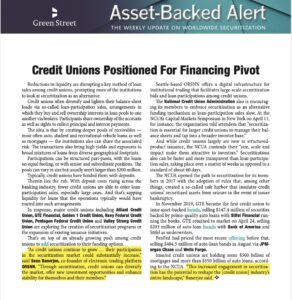This week our CEO, Sean Banerjee, was featured in the Asset-Backed Alert in an excellent article on how credit unions are positioned for a financing pivot! We’ve prepared a summary of the article here, or you can read the whole document below to discover how ORSNN is uniquely positioned to be a part of this revolutionary transition.
Liquidity Reductions are Driving Change
Reductions in liquidity are disrupting a key method of loan sales among credit unions, prompting more of the institutions to look at securitization as an alternative.
Credit unions often diversify and lighten their balance-sheet loads via so-called loan-participation sales, arrangements in which they buy and sell ownership interests in loan pools to one another via brokers. Participants share ownership of the accounts as well as rights to collect principal and interest payments.
The idea is that by creating deeper pools of receivables — most often auto, student and recreational-vehicle loans as well as mortgages — the institutions also can share the associated risk. The transactions also bring high yields and exposures to broad mixtures of loans from diverse geographical footprints.
Deposit Costs are Rising
Participations can be structured pari-passu, with the loans on equal footing, or with senior and subordinate positions. The pools can vary in size but usually aren’t larger than $200 million. Typically, credit unions have funded them with deposits.
Therein lies the rub. With deposit costs rising across the banking industry, fewer credit unions are able to enter loan-participation sales, especially large ones. And that’s sapping liquidity for loans that the operations typically would have routed into such arrangements.
In response, major credit unions including Alliant Credit Union, GTE Financial, Golden 1 Credit Union, Navy Federal Credit Union, Pentagon Federal Credit Union and Valley Strong Credit Union are exploring the creation of securitization programs or the expansion of existing issuance initiatives. That’s on top of an already growing push among credit unions to add securitization to their funding options.
“Securitization is essential for larger credit unions to manage their balance sheets and tap into a broader investor base,” said the National Credit Union Administration (NCUA) at the Capital Markets Symposium in New York.
And while credit unions largely are new to structured-product issuance, the NCUA contends their “size, scale and impact make them attractive to investors.”
ORSNN offers a digital infrastructure for institutional trading that facilitates large-scale securitization bids and loan participations among credit unions, reducing costs and transaction times and, as such, is uniquely positioned to facilitate this pivot.
The Path to Securitization was Opened in 2017
The NCUA opened the path to securitization for its members in 2017 with the adoption of rules that, among other things, created a so-called safe harbor that insulates credit unions’ securitized assets from seizure in the event of issuer bankruptcy.
In November 2019, GTE became the first credit union to issue asset-backed bonds, selling $147.4 million of securities backed by prime-quality auto loans with Stifel Financial running the books. GTE returned to market on April 24, selling $203 million of auto-loan bonds with Bank of America and Stifel as underwriters. PenFed had priced the most recent offering before that, selling $484.5 million of auto-loan bonds in August via JPMorgan Chase and Wells Fargo.
Insured credit unions are holding some $500 billion of mortgages and more than $350 billion of auto loans, according to the NCUA. The increased engagement in securitization has the potential to reshape the credit union industry’s entire landscape.
Click on the image below to download and read the entire article.




